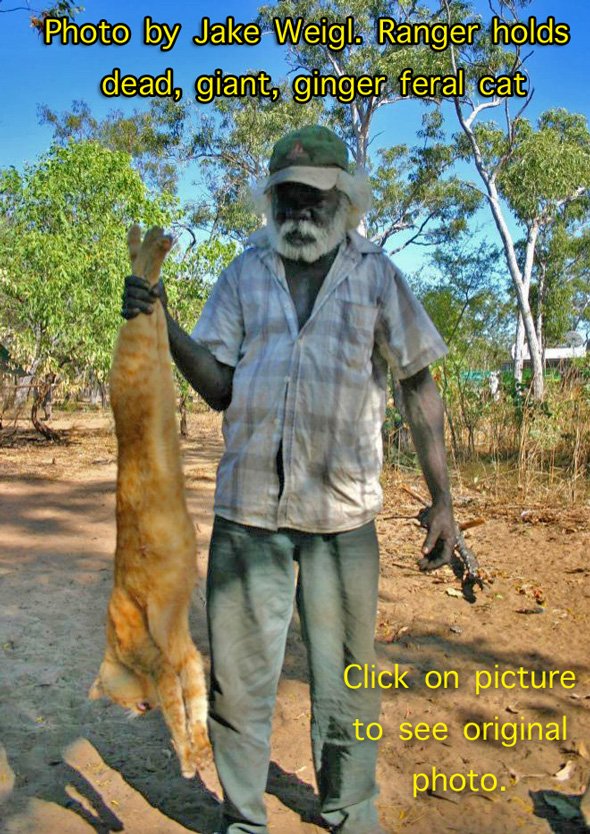 The process of the unraveling of the domestication of the cat seems to be taking place in parts of Australia. Stray cats are becoming feral and the feral cats are becoming bigger and smarter. They are looking and behaving like their wildcat ancestor. They may even be a better predator than the wildcat. They are entering a phase of reverse evolution, turning the clock back 10,000 years to return to their roots and become a modern version of the Near Eastern Wildcat, felis silvestris lybica. I would expect the new wildcat to be superior to the Near Eastern Wildcat. The taxonomists would have to classified it as a new subspecies of wildcat.
The process of the unraveling of the domestication of the cat seems to be taking place in parts of Australia. Stray cats are becoming feral and the feral cats are becoming bigger and smarter. They are looking and behaving like their wildcat ancestor. They may even be a better predator than the wildcat. They are entering a phase of reverse evolution, turning the clock back 10,000 years to return to their roots and become a modern version of the Near Eastern Wildcat, felis silvestris lybica. I would expect the new wildcat to be superior to the Near Eastern Wildcat. The taxonomists would have to classified it as a new subspecies of wildcat.
What I have said in the first paragraph is part fiction and part fact. The Australian authorities are genuinely concerned about super feral cats. They are obsessed with them and abusing them. Super feral cats are very similar to the species called the wildcat in behavior and skills. The outback in Australia is vast. People population densities are very low. There is plenty of prey for a modern-day wildcat. The super-feral-cat/wildcat can thrive under these conditions. By domestic cat standards, they are able to claim very large home ranges – territories that they regard as their home.
Officially there are no wild cat species in Australia but the way things are developing, perhaps one day there may be. The Aussie super-feral-cat story is an example of the early stages of reverse evolution or the ‘undomestication’ of the domestic cat via feral cats. Feral cats are wild but not try wildcats. There is a difference. Also, the super feral cat makes for good sport hunting for Aussie’s who like to shoot at something.
Note: there are stories of leopard-sized feral cats in Australia. I really don’t think this is realistic. I don’t even think they are hybrids. They are just fiction.
I’d like to thank Harvey Harrison for the idea behind this article. There are more articles on Australia’s feral cats at the base of the page.
If the cat is ‘undomesticating’ itself in parts of Australia, it begs the question whether domestication of the wildcat would take place today.
Would domestication of the wildcat take place today?
The wildcat, today, would not drift into domestication because the original conditions under which cat domestication took place hardly exist.
The original act of domestication, about 10,000 years ago, is described as a “mutual arrangement” or agreement because both human and cat benefited. The Near Eastern Wildcat found life easier because prey was more abundant near grain stores. The farmer became more efficient because his grain was protected.
The circumstances have changed dramatically. Full-time indoor cats being fed commercially prepared dry kibble is not what the cat agreed! What the domestic cat wants is as natural a life as possible because he is made for that.
Where there is the opportunity, the domestic cat could and would revert to the wildcat but it would take a long time. It could be argued that every domestic cat born has to be domesticated through socialization during the first weeks. In other words, domestication is not hard wired.
Of course, you cannot place a domestic cat outside and expect him to survive. A few will. Most will perish. Their skills are too rusty. However, the stray cat turns feral and over time offspring evolve into super skilled predators of abundant wildlife. They eat well and grow strong. They have a better life. On that basis the domestic cat would no longer agree to be domesticated.
One last, important, point: people kill far more wildlife than super feral cats through their rampant activities which invariable includes the destruction of habitat and prey items that sustain wildlife. People should be less hypocritical on the subject of wildlife conservation and the damage done by feral cats.
Note: I have provided a full credit and link to the original picture on this page as “payment” for publishing it in the interests of trying to improve our knowledge of cats.

SOME MORE ON AUSTRALIA:


Evolution of the Australian Outback Wildcat in progress?
arokpodcast.wordpress.com/2021/09/02/evolution-of-the-australian-outback-wildcat-in-progress/
Great. I like your comment. It makes sense. I presume you live in Australia. If you do I’d like to hear more about cats from Australia. Please stick around 😉